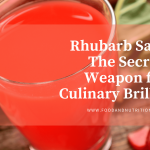Rhubarb Sauce: The Secret Weapon for Culinary Brilliance

Rhubarb sauce, with its vibrant color and unique flavor profile, has gained immense popularity in the culinary world. This versatile sauce, made from the stalks of the rhubarb plant, offers a delightful balance of tanginess and sweetness that can elevate a wide range of dishes. In this blog post, we will delve into the history of rhubarb sauce, explore its popularity, highlight its common ingredients and nutritional benefits, and provide creative serving ideas. Prepare to be convinced that rhubarb sauce deserves a spot in your culinary repertoire!
The History of Rhubarb Sauce
Rhubarb, native to Asia, has a long and intriguing history. It was initially cultivated for its medicinal properties before finding its way into the realm of cooking. While the precise origins of rhubarb sauce are unclear, it is believed to have emerged in Europe during the 18th century, where rhubarb gained popularity as an ingredient in desserts and sauces. Since then, it has become a cherished culinary tradition in many parts of the world, including North America.
Why Rhubarb Sauce is Popular
Rhubarb sauce’s popularity stems from its unique flavor and its versatility in the kitchen. The tangy and slightly sour taste of rhubarb is beautifully balanced with the addition of sugar, resulting in a sauce that is both refreshing and indulgent. Its bright, vibrant color adds visual appeal to any dish, making it a popular choice for garnishing and enhancing the overall presentation. Additionally, rhubarb sauce pairs harmoniously with a variety of foods, from classic pairings like ice cream and pancakes to more adventurous combinations with savory dishes.
Common Ingredients in Rhubarb Sauce
To create a delectable rhubarb sauce, you will need a few simple ingredients. The star of the show is, of course, fresh rhubarb stalks, which provide the distinct flavor and vibrant color. Sweetness is added with sugar, balancing the tartness of the rhubarb. Water helps to cook the rhubarb and create a smooth consistency, while a touch of vanilla extract can be included for an extra layer of flavor. These basic ingredients come together to create a sauce that can transform any ordinary dish into a culinary masterpiece.
Rhubarb Sauce
Ingredients
- 4 cups chopped rhubarb
- 1 cup sugar
- 1/2 cup water
- 1 teaspoon vanilla extract optional
Instructions
- saucepan over medium-high heat and bring the mixture to a boil, stirring occasionally.
- Reduce the heat to medium-low and let the mixture simmer for 15-20 minutes, or until the rhubarb is soft and easily falls apart.
- Remove the saucepan from the heat and allow the mixture to cool for a few minutes.
- If desired, add the vanilla extract and stir to incorporate.
- Using an immersion blender or transferring the mixture to a blender, puree until smooth.
- If the sauce is too thick, add a little more water to achieve your preferred consistency.
- Serve the Rhubarb Sauce warm or chilled as a delightful topping for ice cream, pancakes, waffles, or any other dessert of your choice.
Notes
Nutritional Benefits of Rhubarb Sauce
Beyond its delightful taste, rhubarb sauce offers several nutritional benefits. Rhubarb is low in calories and fat, making it a guilt-free addition to your culinary creations. It is a good source of dietary fiber, which aids in digestion and promotes a healthy gut. Rhubarb also contains essential vitamins and minerals, including vitamin K, vitamin C, potassium, and calcium. These nutrients contribute to overall well-being and support the proper functioning of various bodily systems.
Serving Ideas
Rhubarb sauce’s versatility makes it a fantastic addition to numerous dishes. Here are some serving ideas to inspire your culinary adventures:
- Dessert Delights: Drizzle rhubarb sauce over vanilla ice cream, cheesecake, or pound cake for an exquisite burst of flavor. It can also be used as a filling for pies, tarts, or crumbles.
- Breakfast Bliss: Start your day on a tangy note by topping pancakes, waffles, or French toast with rhubarb sauce. Alternatively, swirl it into yogurt or oatmeal for a delightful morning treat.
- Savory Sensations: Rhubarb sauce can lend its unique flavors to savory dishes as well. Use it as a glaze for roasted meats or as a condiment alongside cheese and charcuterie boards. The tangy notes can provide a pleasant contrast to rich, savory flavors.
- Refreshing Beverages: Add a spoonful of rhubarb sauce to lemonade, iced tea, or sparkling water for a refreshing twist. You can also incorporate it into cocktails or mocktails for a burst of fruity flavor.
Conclusion
Rhubarb sauce, with its rich history, delightful taste, and versatile applications, has rightfully earned its place as a beloved culinary gem. Its tangy and sweet flavors bring a unique dimension to a wide range of dishes, making it a valuable addition to any kitchen. Whether you’re seeking a show-stopping dessert, a vibrant breakfast accompaniment, or an unexpected twist in your savory creations, rhubarb sauce is sure to impress. Embrace the magic of rhubarb sauce and let your culinary creativity soar!
- Unlock Classic Marinara Sauce: A Flavorful & Nutritious Guide
- Embracing Summer: The Ultimate Watermelon Feta Salad with Tomatoes & Olives
- Rediscovering Lebanese Salad: A Refreshing Delight with a Rich Heritage
- Eating Your Way to Healthy Blood Pressure: A Guide to Lowering Hypertension
- Perfect Roasted Leg of Lamb: A Timeless Delight for Your Table
- Romesco Sauce: A Flavorful Spanish Delight That Elevates Every Dish
